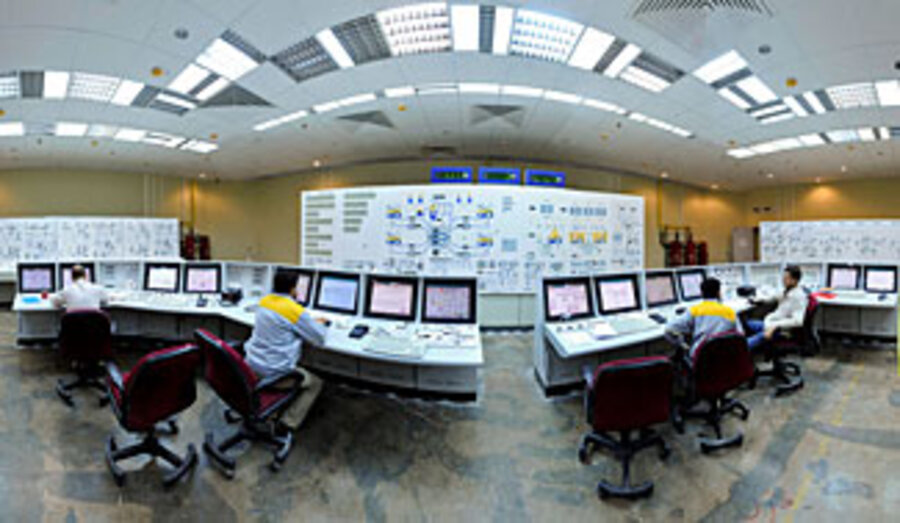Iran nuclear program: Can it produce its own fuel?
Loading...
| Istanbul, Turkey
Iran's President Mahmoud Ahmadinejad says Iran will make its own higher enriched nuclear fuel, effectively rejecting a UN-backed exchange proposal that would have eased Western fears about Iran's nuclear program.
A defiant Mr. Ahmadinejad said on Wednesday that Iran was tired of the continued sparring over a swap offer, in which it would ship out its own low-enriched uranium, purified to less than 5 percent, for the 20-percent enriched fuel it needs.
"I declare that by the grace of God, the Iranian nation will produce 20 percent enriched uranium and anything it needs itself," Ahmadinejad told thousands of people in the central city of Isfahan. It was Iran's latest volley in a nuclear back-and-forth with the UN nuclear watchdog agency and the five permanent UN Security Council members plus Germany.
Yet analysts cast doubt on Iran's technical and industrial capacity to fulfill either that pledge, or the dramatic expansion of Iran's nuclear enrichment effort announced last Sunday.
Iran is not known to have the technology to fabricate its own fuel rods. France and Argentina are practically alone in being able to supply the specific fuel needed by Iran's small reactor to continue producing medical isotopes in Tehran.
Iran censured last week
The US has led Western efforts for the deal, which would have seen Iran reduce the amount of material inside the country that could hypothetically be enriched to much higher levels of 90 percent necessary for a weapon.
Iran was censured last week in an overwhelming vote by the International Atomic Energy Agency (IAEA) over its belated declaration of a small, 3,000-centrifuge facility hidden under a mountain near Qom. Revealed in September, inspectors found it to be in an "advanced" stage of construction.
Iran calls the IAEA decision "illegal," and in reaction on Sunday, Ahmadinejad's cabinet approved 10 new industrial-sized enrichment facilities that would mean a 50-fold increase in capacity to more than half a million spinning centrifuges – a goal that would take decades to achieve if actually pursued.
Ahmadinejad said those plans were "not a bluff," during a televised speech on Tuesday.
Yet analysts say the rapid-fire claims of new programs in recent days belie a nuclear program that has had a rocky history of progress. Instructive are the host of problems Iran has already faced in building its first large-scale enrichment facility at Natanz. Designed for some 50,000 centrifuges, just 8,700 have been installed after nearly a decade.
"Iran would probably need to develop significantly stronger domestic capabilities if it were to come anywhere close to meeting this new goal," says Michael Levi, a fellow at the Council on Foreign Relations in New York who has followed Iran's nuclear program for years.
"They are still significantly dependent on imports for their program," says Mr. Levi, author of "On Nuclear Terrorism." "Iran has been casting its net wide for materials and equipment as its dependable suppliers have become more difficult to deal with…. It's gotten harder for them."
Restrictions have tightened with three sets of UN Security Council sanctions, one set of US sanctions, and a host of other US-led bilateral, European, and Israeli efforts, which reports suggest include sabotage of some nuclear components coming from abroad.
In recent years, Iran has had to make design decisions "based less on choosing the optimal technical route," such that the "ability to procure certain things overrode everything else," notes Levi. "There is a cat and mouse game … it's a continuing fight."
Monitoring Iran's procurement network
That fight may have helped US and Western intelligence agencies determine that the facility near Qom, called Fordo and situated on a Revolutionary Guard military base, had a nuclear purpose.
Obama administration statements "strongly suggest to me that we have their procurement network, at least a part of it, pretty well penetrated," because the arrival of certain material was the tipoff that it was a centrifuge facility, says a US government nonproliferation expert who asked not to be named. "We know they're out shopping, and we're trying to stop that."
This analyst notes that Iran has slowed installation of new centrifuges in recent months, and stated in late September that it would concentrate on more sophisticated and efficient centrifuges.
Iran has reacted strongly to the IAEA censure. On Wednesday, Ahmadinejad said Western countries "once again showed that they are not committed to the law. They make use of international bodies as tools.… the era of such childish games are over."
The Iranian president had earlier singled out Russia, which is building Iran's only nuclear power plant at Bushehr. "Russia made a mistake," Ahmadinejad said on Tuesday. "It does not have an accurate analysis of today's world situation."
Reuters reported on Wednesday from Moscow that Russia would join any "consensus" on more sanctions against Iran, which US officials suggest will be a top priority in the New Year if no compromise deal is reached.
Though all decisions on nuclear and other key state issues in Iran are made by Supreme Leader Ayatollah Seyyed Ali Khameini, the comments by Ahmadinejad appeared to make a compromise exchange deal less likely. Given current limitations, it was not clear how Iran would boost its capabilities.
"Based on what the Iranians have demonstrated, it would be surprising if they were able to manufacture anywhere near the number of centrifuges they need" for the declared enrichment expansion, says the US government expert. "Iran also does not have a large supply of indigenous uranium. I don't think they have enough even to fuel a Bushehr-sized reactor, let alone run that many centrifuges. It's ridiculous."
Also:





